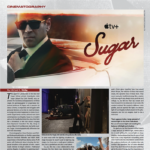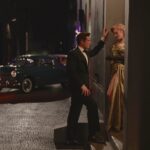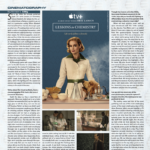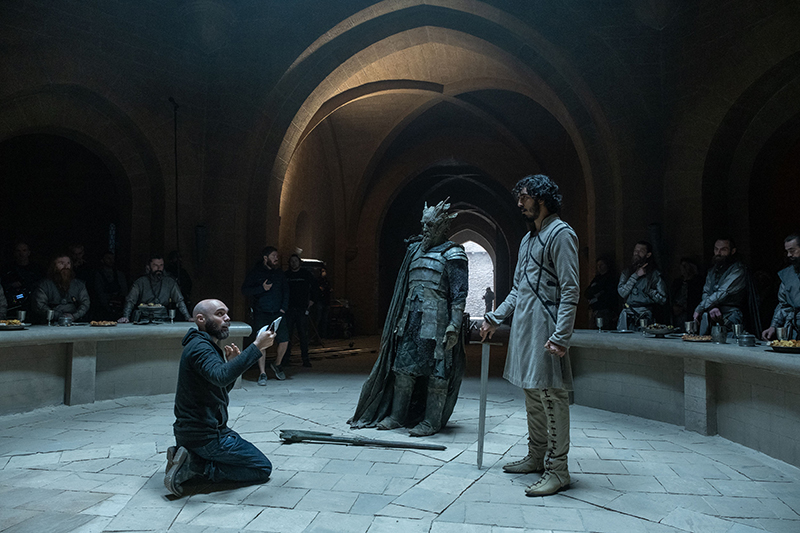
The 14th-century poem, Sir Gawain and the Green Knight, one of the most beloved and mysterious sagas in the King Arthur and the Knights of the Round Table collection of stories, has recently undergone a radical revamp.
Now the subject of a full-length feature film titled The Green Knight, the David Lowery-directed movie, starring Dev Patel as Gawain, has been generating a major buzz with online fans and fantasy film buffs, alike. Covid delays may have kept The Green Knight out of cineplexes for months, but anticipation has fueled speculation about its content and the overall look of the film.
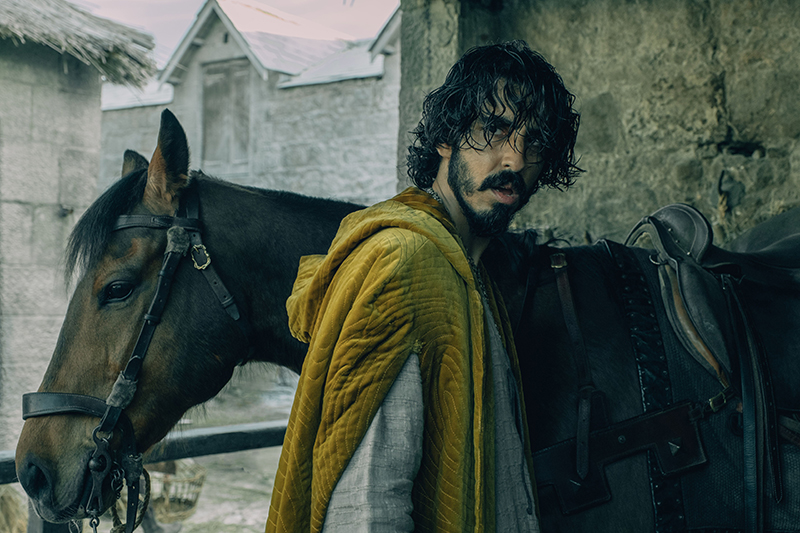
Cinematographer Andrew Droz Palermo, who’d worked on 2012’s V/H/S, 2011’s You’re Next and Lowery’s A Ghost Story (2017), brought a wealth of ideas that dovetailed nicely with the movie’s setting and overall conceptual themes. Palermo’s choice of color palette, willingness to experiment, cyclical motifs and respect for the natural environment may make The Green Knight, for some viewers, unlike any other in the canon of Arthurian cinematic features.
For over a decade, Palermo’s portfolio of intelligently designed hypnotic visuals has grown to include shorts, videos and feature films. His work with rock band White Rabbits for the 2009 song, “Percussion Gun,” for instance, sweeps up the viewer in a whirlwind of blinding lights, choreographed African-style tribal drums, and Zeotropic-like, 360-degree hallucinatory imagery.
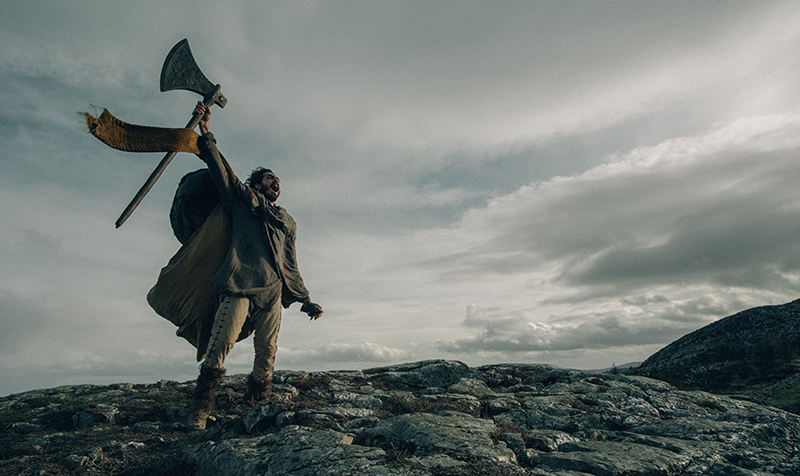
…And the Horse He Rode In On
An ancient mythic poem, such as Sir Gawain and the Green Knight, warrants a little background before we proceed. Penned by an anonymous author believed to be from the West Midlands in England, Sir Gawain and the Green Knight captured the imagination of celebrated 19th Century folklorist Jessie L. Weston (From Ritual to Romance) and legendary fantasy novelist J.R.R. Tolkien, both of whom translated the work into modern English.
The so-called metrical romance appears in various Arthurian anthologies, but with some slight variation. The basic version goes something like this: a Yuletide/New Year’s Day celebration at King Arthur’s court brings an unexpected visitor to Camelot — a giant stranger, whose body appears as if it had been composed of organic materials found in nature. Everything about the stranger is green — his clothes, beard, even the very horse he mounts.
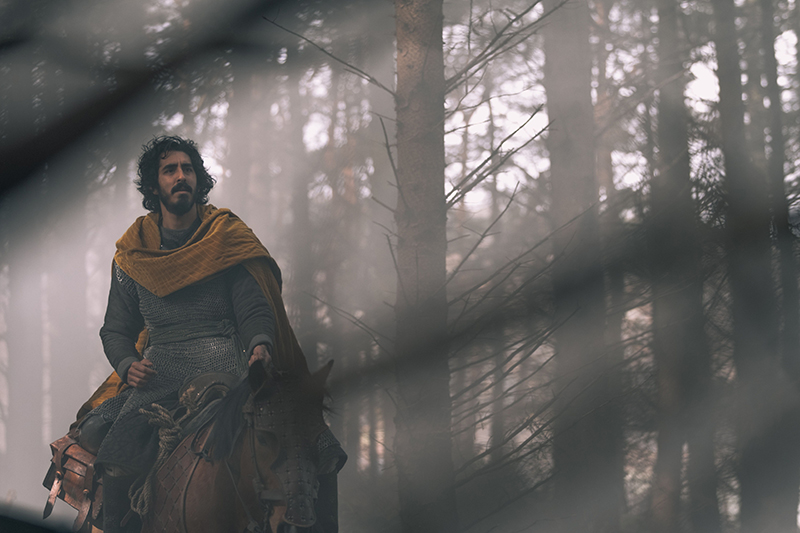
The Green Knight intends to perpetrate no violence, however, but pose a challenge for one of Arthur’s finest. The terms of this sporting match? A lone warrior can strike the Green Knight once, and only once, using the gargantuan gamester’s own mighty axe. Should the Green Knight absorb the punishing blow, the mossy monstrosity reserves the right to retaliate in kind — one year and a day into the future.
Arthur willingly takes up the challenge, but he’s rebuked by the mysterious figure, who demands one of the Camelot’s brave knights step up instead. Arthur’s nephew, the gentlemanly Gawain, answers the call, and in so doing, places himself on the chopping block, both figuratively and ultimately quite literally. When Gawain raises the axe and slashes at the Green Knight, severing his head from his body, the giant does not waver, nor does he die. The Green Knight picks up his noggin, holds it by its long locks of hair, and hops upon his steed.
Just before riding off, the headless horseman reminds Gawain of his pledge and their fateful meeting one year hence at the Green Knight’s fortress…
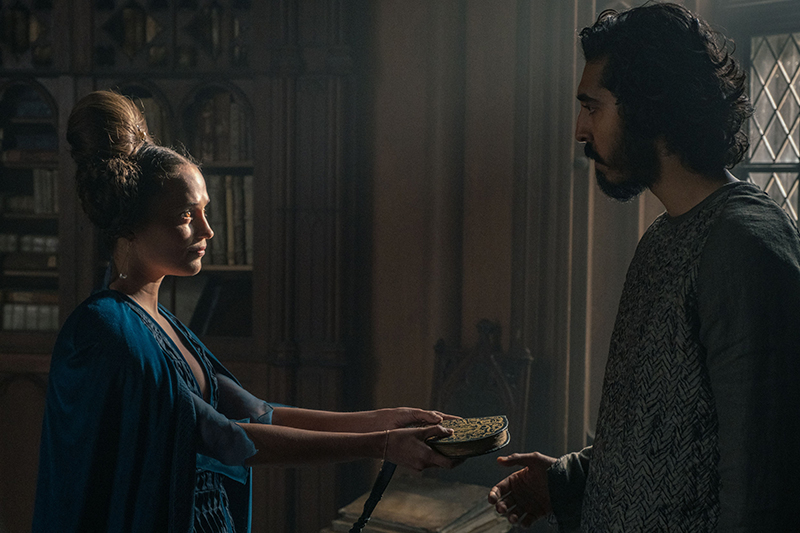
More than a myth about the value of maintaining a chivalrous code and honoring one’s debt, The Green Knight presented wide-screen filmic potential readily apparent to both Lowery and Palermo. The figure of the Green Knight embodies nature’s great paradox: with metaphysical transcendence comes enormous real-world danger. Indeed. The Green Knight ushers us along on a 12-month sojourn that travels the landscape of the soul, fusing Gawain’s spiritual quest of self-realization and the knight’s physical journey through dense forests and strange wilderness.
Visual depth and unpredictability are some of The Green Knight’s cinematic strengths, although the film’s near-psychedelic scenes have motivated some to compare Lowery’s 2021 theatrical release to John Boorman’s mesmerizing 1981 fantasy epic, Excalibur, featuring Liam Neeson as Gawain and lensed by Oscar-nominated cinematographer Alex Thomson.
Thomson used an ArriFlex 35mm BL3 camera to help achieve the surrealistic qualities of the production and, for The Green Knight, Palermo tapped an Alexa 65mm digital camera and Arri DNA lenses as well as Tokina cameras “for a few other wide lenses,” says Palermo. “This movie is shot incredibly wide on this large format 65, and needed a couple others to go even wider.”
Filming, which took place mostly in Wicklow, Ireland, spanned 40 days, with about a week extra for pickups. Lowery and Palermo were present for virtually every shot. “We scouted Ireland and Budapest, but when we came to Hungary, and it was 100 degrees, we knew it was not as green, lush and alive as we wanted it to be,” says Palermo. “When we went to Ireland, I mean, David, Toby [Halbrooks], our producer, and I … we were in heaven.”
When PLSN caught up with Palermo, he could not reveal much about his current assignment, except to report that he was in Hungary shooting a television series rooted in the Marvel Comics universe. What follows is a brief Q&A with the cinematographer.
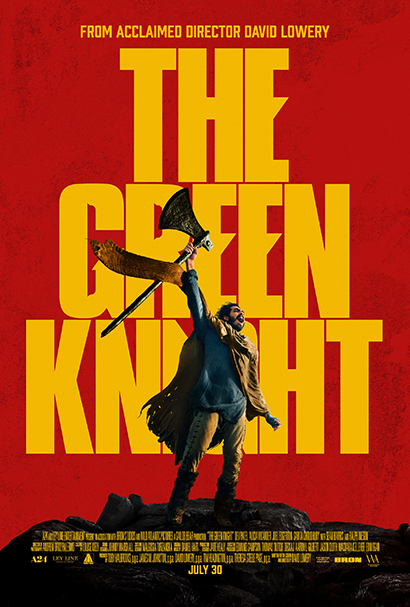
PLSN: You’ve talked about your love of nature. It’s interesting that you got the call for this movie.
Andrew Droz Palermo: I had worked with David [Lowery] before, but I do think that my love of nature played a part in my photography and shooting in the movie, the landscapes and trees … I was pitching David on a montage of trees at one point in the movie.
Did David allow you some latitude with that?
Definitely. There’s a big presence of nature in [the film]. At the beginning of the film, Gawain passes by loggers, and we wanted to make it feel as though there was lots of deforestation going on and building up of the civilization of Camelot. Then the environment becomes greener and greener when Gawain gets into the Green Knight’s realm.
On his journey, Gawain enters a forest with an amber glow. How did you achieve this look?
That was something I started testing early on, about what the flavor of that would be. We knew we wanted it to feel as though he was descending into something which felt like madness. My first instinct, being that the film is The Green Knight, was to go green. Almost immediately beyond that, I wanted it to feel more feverish and tropical, and it started me thinking about Vittorio Storaro’s looks in Apocalypse Now. I had an image in mind, and once we started shooting, I would push the image digitally in addition to wearing some color filters in front of the lens just to give the whole image a wash of this color, so it wasn’t entirely post-manipulated. The idea was that this is an intense and modern, even psychedelic, journey, not a desaturated Medieval movie. An acid trip — that’s what some people keep calling it.
Did you apply green lighting liberally throughout the shoot?
I didn’t end up doing too much of it, just because I wanted to shy away from what might have been expected, color-wise. However, any time I had the presence of witchcraft, I started pushing a little green into it. These characters were more in touch with nature and were challenging something that the other people in the film had lost touch to.
Is the Green Knight character live action and CGI?
I would say 99-percent practical. The only time he is not practical is when he is beheaded; he is holding up his head and the eyes were blinking and they were composited onto him. Incredible make-up and prosthetic work.
Cyclical concepts or circular designs appear throughout this film. A season wheel, a royal seal, light streaming through a circular skylight, halo crowns, and of course the Round Table itself. Was this deliberate?
It certainly was. Cycles were important to us as the film takes place in one year’s time. A lot of David’s work deals with time. Finding ways of bringing that in visually was fun, like the skylight you’d mentioned, in the great hall in Camelot. There is also some witchcraft that deals with the cycles of time.
What other scenes regarding lighting stand out for you?
The great hall is what the film opens with, and that was such a difficult bit of photography. It’s a big set, and there’s a massive, massive scene that takes place in it. There is one that I love that has a little bit of witchcraft happening and that was done very simply, on a location, with an overhead Skypanel and some Skypanels blacking out the windows … ND-ing them way, way down and just glowing them a bit. I love pinpoints of light … and in this scene in particular, I lit with 360 in mind, so that we can move the actors, and move quickly. It’s nice to have little points of light behind.
There’s a lot of great stuff later in the film that takes place in lord and lady’s castle. I used a 50K SoftSun to do this beautiful soft daylight and then did deep firelight stuff, when they are sitting around having these sort of fireside chats. We are feeling the flicker on their faces, and I let the room go black as much as I could, picking up little areas of light. It’s a matter of how much you can get away with, pushing things to the edge of visibility. You have to ride a fine line and be a little scared you are underexposing too much.
Does this look pop up again in the film?
Without spoiling too much, Gawain meets this one person on his quest, and in this scene, in particular, I tried to push so low on the light. There was just the smallest light possible to see the person’s face to understand there was a person there, but also to give them the tiniest little kiss of an eye light so that those two pings in their eyes act as grounding. You have their eyes even if their face and the background are in shadow. The Green Knight has them, Gawain will often have them, and the scene might be very dark, but if you have the anchor of their eyes, it can draw you in.
Not to change gears, but you’ve been outspoken about your depression.
Especially on this film, I felt better than I had personally felt in a very long time. That was largely due to having a really strong structure and exercising and eating well and just taking care of myself physically while shooting.
Was shooting The Green Knight therapeutic?
Yeah. David and Toby [Halbrooks], our producer, the three of us challenged one another to run a half-marathon, just to set some other goal to focus on while making the movie. You can really just toss your physical health aside while shooting, and you get tunnel vision. You start eating poorly on set… I’m glad you asked about that. I have never been asked about that in an interview.
